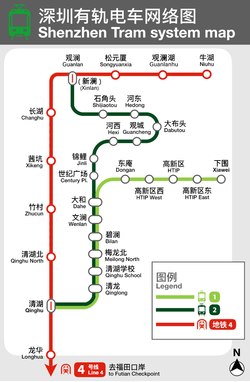Shenzhen Tram
 |
|||
|
|||
Shenzhen Tram is a light rail system consisting of three tram lines in Longhua District, Shenzhen, Guangdong, China. Construction commenced on 27 December 2013 and public testing started on 30 June 2017. The tram system will integrate the north side of Longhua into the city’s rail network and is expected to significantly ease commuting difficulties, especially since the northern extension of Shenzhen Metro Line 4 is still being planned.
The initial system consists of 11.7km and three lines. The tram will link Qinghu Station on Line 4 of the Shenzhen Metro with central Guanlan, with service to Longhua areas including Automobile Industry City, Guanlan Strategic New Industries Park and the Science and Technology Service Center. It will eventually connect with Shenzhen Metro Line 4 at Xinlan Station. There will be 21 stations at a cost of about 1.38 billion yuan (US$226 million). It is expected to help residents commute and relieve traffic congestion in the local area. A 3.8-kilometer spur links Guanlan New Industry Park with Dahe Road. The spur is expected to cost 218 million yuan.
Zhao Pinglin, Deputy Director of Shenzhen Rail Construction Headquarters, said tram systems have shorter, cheaper construction periods than metro and light rail. Modern tram systems also have lower energy consumption, more flexibility and quieter operations, Zhao said. Longhua is planning three tram lines totaling 51 kilometers. Construction of metro projects can take four to five years and cost 600-700 million yuan per kilometer, while tram lines can cost about 100 million yuan per kilometer and be used for 30 years. The tram has been criticized for roughly following the path of the under construction north extension of Shenzhen Metro Line 4 rendering the project redundant. However, given that the goal of the tram project was to improve short distance transport and serve as a feeder line to the metro, the tram project will complement the Metro extension rather than compete with it.
...
Wikipedia

